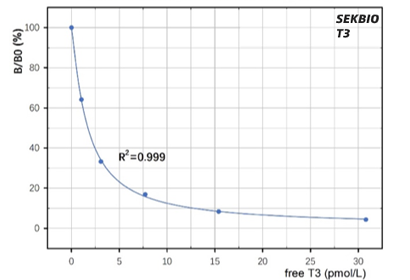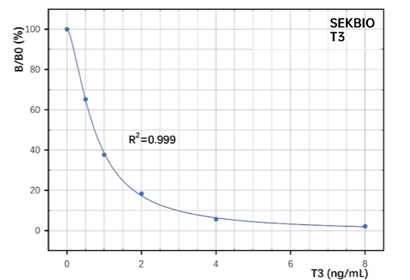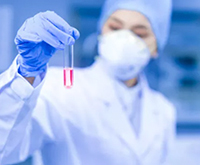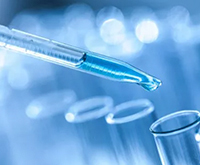Triiodothyronine (T3)
Triiodothyronine, also known as T3, is a thyroid hormone. It affects almost every physiological process in the body, including growth and development, metabolism, body temperature, and heart rate.
The determination of triiodothyronine is one of the sensitive indexes in the diagnosis of hyperthyroidism.
When elevating hyperthyroidism, it is also the precursor of the recurrence of hyperthyroidism. In addition, pregnancy and acute hepatitis will advance Hypothyroidism, simple goiter, acute and chronic nephritis, chronic hepatitis, cirrhosis of the liver.
T3 can be used to diagnose T3-hyperthyroidism, early detection of hyperthyroidism, and diagnosis of pseudo thyrotoxicosis.
The serum T3 and T4 levels changes are generally consistent, which is a sensitive indicator of thyroid function diagnosis, especially important for early diagnosis. It is a specific diagnostic indicator of T3 hyperthyroidism.
Types Of Triiodothyronine (T3)
| Antibody | Application |
| Sheep Anti-human T3 mAb | For immunodiagnostic: ELISA, LFA, CLIA |
Triiodothyronine Intro
As the largest endocrine gland in the human body, the thyroid secretes the main active substances, tetraiodothyronine (T4) and triiodothyronine (T3), which are extremely important for protein synthesis thermoregulation, energy production, and regulation effect.
T3 plays a vital role in judging the physiological condition of the human body, so it is of great significance to detect the content of T3 in serum. The content of T3 in serum is 1/80~1/50 of that of T4, but the biological activity of T3 is 5~10 times that of T4. Most of the T3 in serum is converted from the deiodination of peripheral tissues. A small part of T3 is directly secreted by the thyroid and released into the blood. Most of the T3 in serum is bound to binding proteins. About 90% is bound to thyroxine-binding globulin (TBG), the rest is bound to albumin, and a tiny amount is attached to thyroxine-binding prealbumin (TBPA).
Free T3 Test
Increased T3 is seen in hyperthyroidism, early stage of triiodothyronine-type hyperthyroidism crisis, iodine-deficiency goiter, and hyperthyroid-binding globulinemia.
It is decreased in hypothyroidism, low thyroxine-binding globulinemia, and so on.
High result possible disease: hyperthyroidism.
Low result possible diseases: Hypothyroidism, endocrine proptosis, thyroiditis, resting lymphocytic thyroiditis, hyperthyroidism in children, hyperthyroidism in the elderly, thyroid tuberculosis, endocrine disorders, euthyroid goiter, precocious children Breast hypertrophy.
TT3 Performance Data
Manufacturer | SEKBIO |
Parameter | TT3 |
Linearity | 0.3-10 nmol/L |
Detection limit | 0.3 nmol/L |
Benchmark product | Roche |
Test principle and procedure | TT3: Add 30 μl of sample + 30 μl of Rd, incubation for 10 minutes without cleaning, 30 μl of Ra + 30 μl of Rc and incubation for 5 minutes. Wash with 200 μl of washing solution. Finally, add 100 μl of A + 100 μl of B. |
Precision
Sample | RLU | Concentration | Sample | RLU | Concentration |
0.5 | 270,946 | 0.47 | 5 | 83,336 | 4.10 |
276,899 | 0.45 | 79,406 | 4.42 | ||
278,536 | 0.44 | 82,669 | 4.16 | ||
259,590 | 0.52 | 84,427 | 4.02 | ||
269,690 | 0.48 | 81,363 | 4.26 | ||
270,230 | 0.47 | 79,263 | 4.44 | ||
257,837 | 0.53 | 80,565 | 4.33 | ||
270,880 | 0.47 | 77,389 | 4.60 | ||
279,936 | 0.44 | 81,233 | 4.27 | ||
271,277 | 0.47 | 79,113 | 4.45 | ||
AVE | 270582.10 | 0.47 | AVE | 80876.40 | 4.30 |
SD | 7269.04 | 0.03 | SD | 2169.67 | 0.18 |
CV | 2.7% | 6.1% | CV | 2.7% | 4.2% |
Limit of detection
Sample | RLU | Concentration | ||
Ag Diluent | 980,305 | 1,022,449 | 0 | 0 |
986,963 | 1,001,873 | 0 | 0 | |
984,209 | 1,003,978 | 0 | 0 | |
1,026,252 | 1,000,042 | 0 | 0 | |
1,018,574 | 961,333 | 0 | 0 | |
974,731 | 982,278 | 0 | 0 | |
1,022,323 | 969,066 | 0 | 0 | |
1,071,730 | 968,489 | 0 | 0 | |
1,043,724 | 1,028,076 | 0 | 0 | |
1,014,595 | 1,014,797 | 0 | 0 | |
AVE | 1003789.35 | 0.00 | ||
SD | 28331.30 | 0.00 | ||
AVE+2*SD | 0 | |||
Linear
Sample(nmol/L) | Dilution ratio | Concentration value | Average | ||
10.13 | 1.0 | 10.41 | 10.67 | 10.13 | 10.41 |
8.14 | 0.8 | 8.02 | 7.86 | 8.03 | 7.97 |
6.15 | 0.6 | 5.96 | 5.90 | 5.94 | 5.94 |
4.16 | 0.4 | 3.67 | 3.72 | 3.66 | 3.68 |
2.16 | 0.2 | 1.79 | 1.75 | 1.70 | 1.75 |
0.17 | 0.0 | 0.17 | 0.18 | 0.16 | 0.17 |

Method Comparison
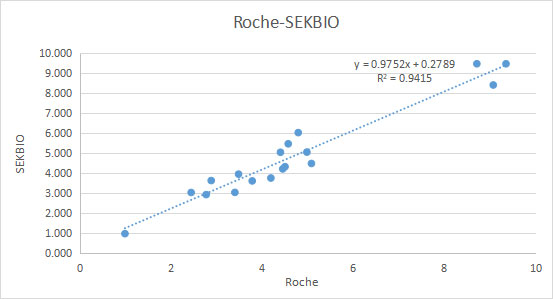
Reagents Stability
Reagent | Sample(nmol/L) | Average | Deviation |
2-8℃ | 9.18 | 55,377 | |
4.71 | 81,863 | ||
0.43 | 340,779 | ||
Antigen diluent | 666,737 | ||
random sample | 200,281 | ||
calf serum | 453,520 | ||
37℃ 1d | 9.18 | 53,767 | -2.91% |
4.71 | 83,258 | 1.70% | |
0.43 | 339,943 | -0.25% | |
Antigen diluent | 664,104 | -0.39% | |
random sample | 188,472 | -5.90% | |
calf serum | 459,529 | 1.32% | |
37℃ 3d | 9.18 | 51,653 | -6.72% |
4.71 | 82,714 | 1.04% | |
0.43 | 360,888 | 5.90% | |
Antigen diluent | 645,376 | -3.20% | |
random sample | 198,372 | -0.95% | |
calf serum | 480,304 | 5.91% | |
37℃ 7d | 9.18 | 49,977 | -9.75% |
4.71 | 78,711 | -3.85% | |
0.43 | 366,369 | 7.51% | |
Antigen diluent | 629,915 | -5.52% | |
random sample | 189,952 | -5.16% | |
calf serum | 486,154 | 7.20% |
Calibrator Stability
Reagent | Sample(nmol/L) | Average | Deviation |
2-8℃ | 6.70 | 43,902 | |
3.70 | 74,473 | ||
0.32 | 310,740 | ||
37℃ 1d | 6.70 | 43,667 | |
3.70 | 76,993 | -0.53% | |
0.32 | 307,831 | 3.38% | |
37℃ 3d | 6.70 | 43,303 | -0.94% |
3.70 | 75,963 | -1.36% | |
0.32 | 306,706 | 2.00% | |
37℃ 7d | 6.70 | 44,214 | -1.30% |
3.70 | 72,454 | 0.71% | |
0.32 | 305,293 | -2.71% |


